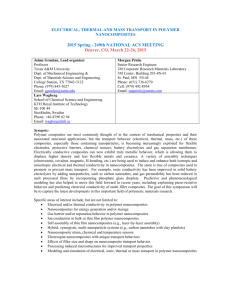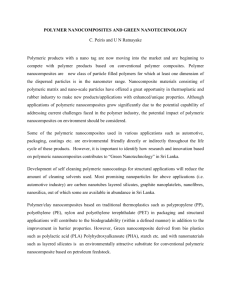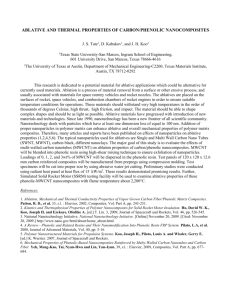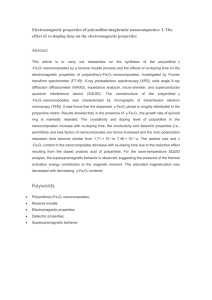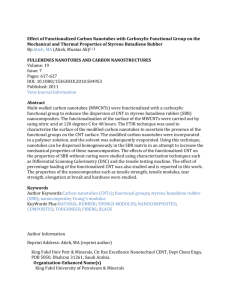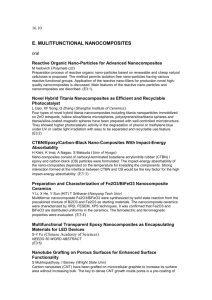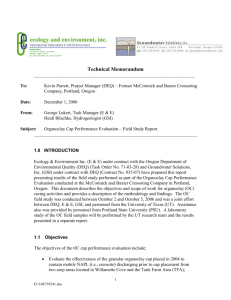Morphology and properties of nanocomposites formed from ethylene
advertisement
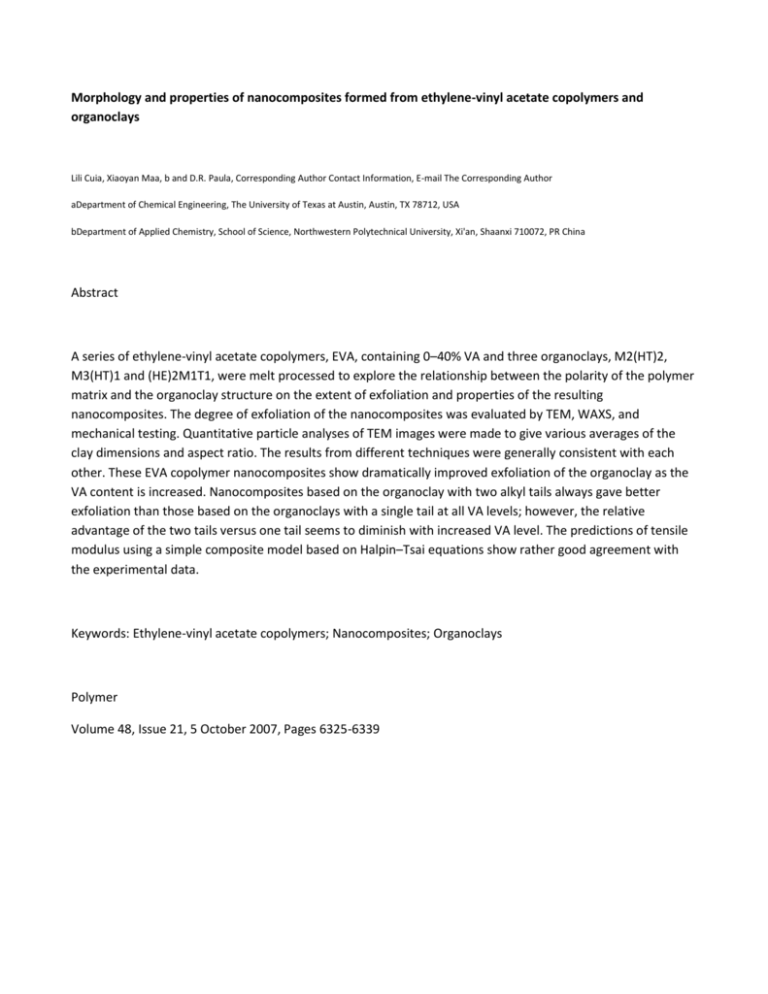
Morphology and properties of nanocomposites formed from ethylene-vinyl acetate copolymers and organoclays Lili Cuia, Xiaoyan Maa, b and D.R. Paula, Corresponding Author Contact Information, E-mail The Corresponding Author aDepartment of Chemical Engineering, The University of Texas at Austin, Austin, TX 78712, USA bDepartment of Applied Chemistry, School of Science, Northwestern Polytechnical University, Xi'an, Shaanxi 710072, PR China Abstract A series of ethylene-vinyl acetate copolymers, EVA, containing 0–40% VA and three organoclays, M2(HT)2, M3(HT)1 and (HE)2M1T1, were melt processed to explore the relationship between the polarity of the polymer matrix and the organoclay structure on the extent of exfoliation and properties of the resulting nanocomposites. The degree of exfoliation of the nanocomposites was evaluated by TEM, WAXS, and mechanical testing. Quantitative particle analyses of TEM images were made to give various averages of the clay dimensions and aspect ratio. The results from different techniques were generally consistent with each other. These EVA copolymer nanocomposites show dramatically improved exfoliation of the organoclay as the VA content is increased. Nanocomposites based on the organoclay with two alkyl tails always gave better exfoliation than those based on the organoclays with a single tail at all VA levels; however, the relative advantage of the two tails versus one tail seems to diminish with increased VA level. The predictions of tensile modulus using a simple composite model based on Halpin–Tsai equations show rather good agreement with the experimental data. Keywords: Ethylene-vinyl acetate copolymers; Nanocomposites; Organoclays Polymer Volume 48, Issue 21, 5 October 2007, Pages 6325-6339 Thermo-mechanical properties of the blend syndiotactic/atactic polystyrene after crystallization of the syndiotactic polystyrene Martin Bonnet1, Maren Buhk1 and Jürgen Petermann1 (1) Department of Chemical Engineering, Institute of Material Science, University of Dortmund, Emil-Figge-Strasse 66, D-44221 Dortmund, Germany, DE Abstract The thermo-mechanical properties of the blend syndiotactic polystyrene (sPS)/ atactic polystyrene (aPS) are characterized by studying the concentration depending softening behavior with thermo-mechanical analysis (TMA) and the temperature depending Young's modulus for different concentrations with dynamic mechanical analysis (DMA). Journal Polymer Bulletin Issue Volume 42, Number 3 / March, 1999 Evaluation of amine functionalized polypropylenes as compatibilizers for polypropylene nanocomposites Lili Cuia and D.R. PaulCorresponding Author Contact Information, a, E-mail The Corresponding Author aDepartment of Chemical Engineering and Texas Materials Institute, The University of Texas at Austin, Austin, TX 78712-1062, USA Abstract The compatibilization effects provided by amine functionalized polypropylenes versus those of a maleated polypropylene, PP-g-MA, for forming polypropylene-based nanocomposites were compared. Amine functionalized polypropylenes were prepared by reaction of maleated polypropylene, PP-g-MA, with 1,12diaminododecane in the melt to form PP-g-NH2 which was subsequently protonated to form PP-g-NH3+. Nanocomposites were prepared by melt processing using a DSM microcompounder (residence time of 10 min) by blending polypropylene and these functionalized materials with sodium montmorillonite, Na-MMT, and with an organoclay. X-ray and transmission electron microscopy plus tensile modulus tests were used to characterize those nanocomposites. Composites based on Na-MMT as the filler showed almost no improvement of tensile modulus compared to the polymer matrix using any of these functionalized polypropylenes, which indicated that almost no exfoliation was achieved. All the compatibilized nanocomposites using an organoclay, based on quaternary ammonium surfactant modified MMT, as the filler had better clay exfoliation compared to the uncompatibilized PP nanocomposites. Binary and ternary nanocomposites using amine functionalized polypropylenes had good clay exfoliation, but no advantage over those using PP-g-MA. The PP-g-MA/organoclay and PP/PP-g-MA/organoclay nanocomposites showed the most substantial improvements in terms of both mechanical properties and clay exfoliation. Keywords: Polypropylene; Nanocomposites; Compatibilizer Polymer Volume 48, Issue 6, 8 March 2007, Pages 1632-1640 Grafting of 3-(trimethoxysilyl)propyl methacrylate onto polypropylene and use as a coupling agent in viscose fiber/polypropylene composites T. Paunikallioa, M. Suvantoa and T.T. PakkanenCorresponding Author Contact Information, a, E-mail The Corresponding Author aUniversity of Joensuu, Department of Chemistry, P.O. BOX 111, FIN-80101 Joensuu, Finland Abstract In this work, 3-(trimethoxysilyl)propyl methacrylate (MPTMS) was grafted onto polypropylene (PP) with use of dicumyl peroxide (DCP) as initiator in a twin screw extruder. Two batches of the grafted PP (PPgSIL) were prepared corresponding to two different grafting levels (4 and 8 wt.%). The presence of MPTMS in the PPgSIL samples was confirmed by FTIR, 1H NMR, and elemental analysis. DSC and GPC results showed that the melting point(s) and molar mass of the PP were reduced due to the grafting. The two PPgSIL batches were used as coupling agents in viscose fiber/PP composites, each at three different levels (5, 2, and 1 wt.% of the weight of the composite). PPgSIL had a significant effect on the mechanical properties of the composites. The composites where PPgSIL was applied, the tensile strength increased by 59% relative to the composites without PPgSIL (64.6 MPa vs. 40.7 MPa). For comparison, the viscose fibers were treated with MPTMS in 1 wt.% MPTMS/water solution; however, the improvement in mechanical properties of the viscose fiber/PP composites was considerably less than that achieved with the PPgSIL coupling agent (46.6 MPa vs. 64.6 MPa). Keywords: Polypropylene; Grafting; Coupling agent; Homopolymerization; 1H NMR Reactive and Functional Polymers Volume 68, Issue 3, March 2008, Pages 797-808 Reduced Cost Fabrication of Large Composite Aerospace Structures Through Nanoparticle Modification of Thermoplastics (Preprint) Authors: Gregory R. Yandek; Darrell Marchant; Joseph M. Mabry; Mark B. Gruber; Mark Lamontia; Sandra Cope; ENGINEERING RESEARCH AND CONSULTING INC (ERC INC) EDWARDS AFB CA Abstract To achieve superior mechanical properties and environmental durability in semi-crystalline engineering thermoplastic composites an intermediate degree of molecular ordering is required. While many thermoplastics achieve their potential crystallinities with autoclave processing, only a fraction of that which is desired is developed with lower cost manufacturing processes, viz. automated fiber placement and tape laying featuring polymer chilling from the melt in seconds. Implementation of such processes for the manufacture of large composite aerospace structures is therefore rooted in material selection and the minimization of cycle times. Polyetheretherketone (PEEK) has demonstrated utility in composite structures due to its processing behavior. The cost-driven replacement of PEEK with other materials depends whether desired laminate crystallinities may be attained avoiding costly annealing steps. Polyetherketoneketone (PEKK) represents an alternative but suffers from reduced crystallization rates. The use of nucleating agents presents a route towards enhancing the ordering phenomena in polymers. A study has been undertaken to evaluate the effectiveness of utilizing silicon-based nanoparticles in improving the crystallization kinetics of PEKK. Relevant findings including the impact of the addition of such nanoparticles on other properties will be discussed. Keywords relating to this report: AEROSPACE SYSTEMS , THERMOPLASTIC COMPOSITES , COMPOSITE MATERIALS , FABRICATION , LAMINATES , MECHANICAL PROPERTIES , NANOTECHNOLOGY , NUCLEATE BOILING , STRUCTURES.
